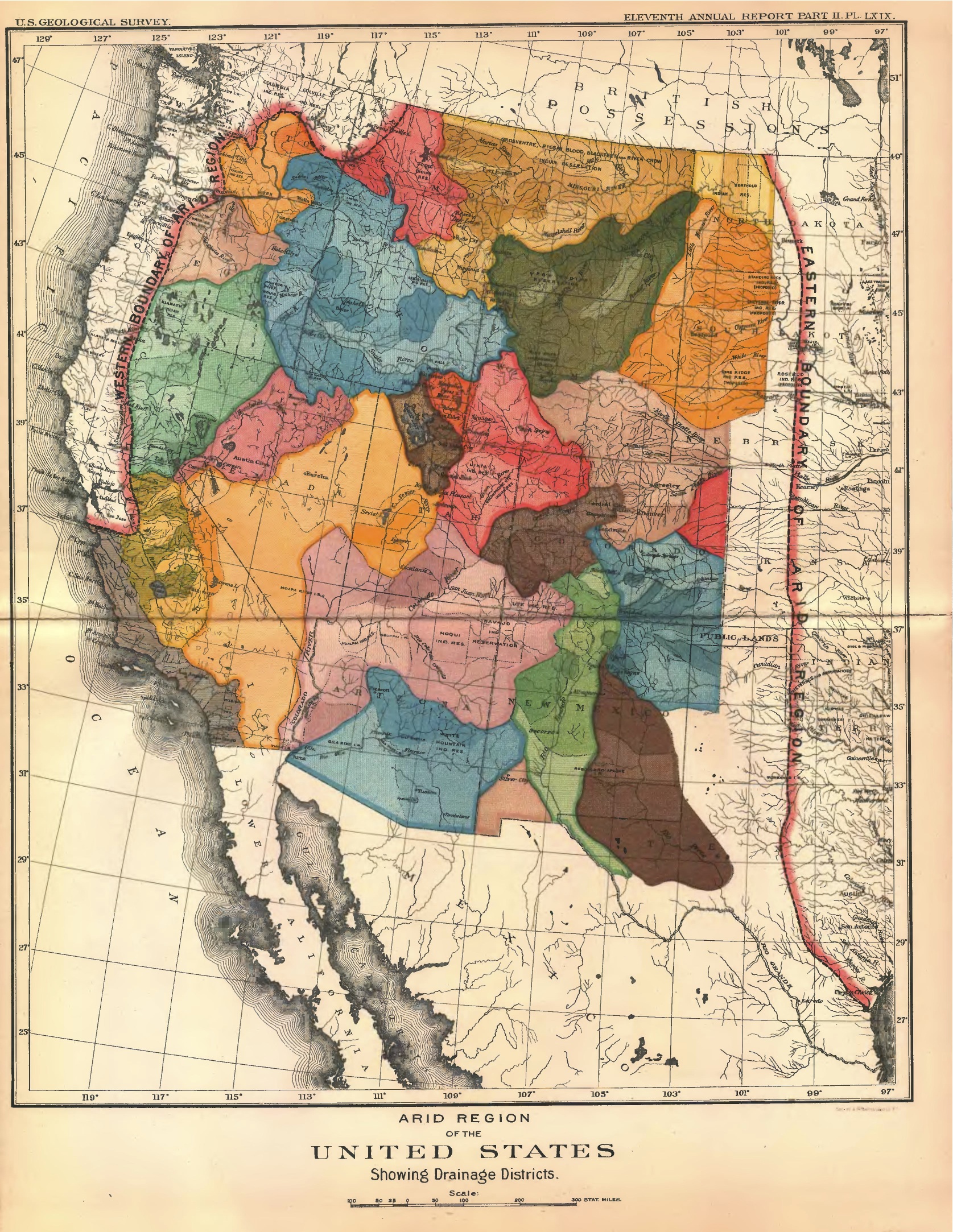Uncategorized
Powell’s vision of the West
Published
6 years agoon
Posted By
Outlaw Partners

Lines drawn by the land and its watersheds
By Bay Stephens
EBS Staff Writer
Dubbed the “Arid Lands” by John Wesley Powell, the American West and its pervasive brown tint dismayed settlers as they moved from fertile eastern states to stake claims in the American frontier. Powell, the iconic, one-handed and self-taught geologist, professor, pioneer and statesman, recognized that water would be the limiting factor in western American development.
Powell sought to organize the sprouting communities in a way that united them around the scarce resource, which would have yielded a very different West than the one that we know today.
According to Dr. Mark Fiege, an environmental historian at Montana State University, the Land Ordinance of 1792 had sectioned the unsurveyed land in the western U.S. into square-mile tracts, or 640-acre parcels. Nearly a century later, the Homestead Act of 1862 and subsequent acts mobilized waves of settlers to the West, granting 160-acre parcels—a quarter of a square mile—to homesteaders with the promise of ownership.
In “Seeing Things Whole,” a collection of Powell’s writings, editor William deBuys writes that “the act guaranteed suffering and sorrow by encouraging people to stake their all on a gamble they were sure to lose,” as less than 20 inches of annual rainfall in the Arid Lands wouldn’t produce a marketable crop. Irrigation was essential to agriculture, but stream flows were diverted until they ran dry, and settlers were often pitted against one another to get enough water to their land.
Unless settlement patterns changed, Powell knew that contention over water would be the heritage of the West. “Powell was a realist when it came to appraising the environmental capacities of the mostly arid West,” Fiege said. Powell saw another way.
During his extensive travels throughout the West, Powell encountered collectivist communities such as the Mormons in Utah and Hispanic villages at the base of Colorado’s Sangre De Cristo Mountains, whose collaborative land management impressed him.
The system employed by the Hispanic villages involved a communal tract of optimally located farmland near the valley floor. A large irrigation ditch—an “acequía madre”—brought water from mountain streams to the farmland, forking into smaller acequías to reach individual plots. Plots were cultivated by separate families but not owned in the way that we define ownership today, Fiege said.
An “ejido”—Spanish for “common land”—surrounded the town and fields, and was unfit for agriculture, used instead as pasturage and timberland.
“You can see there is already imbedded in these lands a notion of collective or communal ownership and operation,” Fiege said. Powell just wanted to scale it up.
He proposed dividing the West into water districts based on hydrographic basins, where those that lived in areas where the waters flowed into the same stream would be members of the same district. The federal government would initially conduct geographic and hydrological surveys to determine boundaries between districts, water volumes caught in each, and lands that could be sustainably cultivated with these waters.
It was a “[a structure] of local government [designed] to nurture the growth of communities in balance with the capacity of the land,” deBuys writes.
Under Powell’s system, the government wouldn’t allow water caught in one hydrographic district to be used in another, or on land not designated as irrigable. That would be the extent of federal involvement, however.
“[Powell] believed that once the central government had established fair rules for economic and social interaction, it should get out of the way,” deBuys writes. It would be the responsibility of the people to govern themselves and their own water usage going forward, making decisions from the perspective of a community with shared interests.
Powell envisioned as many as 150 such commonwealths spread throughout the West. They would function similarly to county districts except the lines would be drawn by the land. Had Powell’s proposals been implemented, the Gallatin-Madison county line wouldn’t split Big Sky in half and satellite images of the western United States wouldn’t reveal sprawling grids of farmland. Some of these watershed commonwealths would straddle two or even three states.
However, by the time Powell presented the most robust version of his idea to the U.S. House of Representatives committee on irrigation around 1890, an array of cultural, historical and political challenges caused Powell’s vision to go unheeded.
It’s difficult to know whether these districts would have been successful. deBuys discusses how, with 150 separate districts, there would have been “150 separate experiments” and as many different outcomes. The functioning of each district would be distinct from any other by virtue of disparate landscapes and watersheds and individuals. Some outcomes may have been little different from what happened in the water-starved West. Others could have exceeded the best of Powell’s hopes for a cooperative agrarian community.
“We will never know,” deBuys writes, “All we can be sure of is that the variety of results would have been greater than that which the Arid Lands have thus far known.”
The Outlaw Partners is a creative marketing, media and events company based in Big Sky, Montana.


Upcoming Events
april, 2024
Event Type :
All
All
Arts
Education
Music
Other
Sports
Event Details
We all are familiar with using a limited palette, but do you use one? Do you know how to use a
more
Event Details
We all are familiar with using a limited palette, but do you use one? Do you know how to use a limited palette to create different color combinations? Are you tired of carrying around 15-20 different tubes when you paint plein air? Have you ever wanted to create a certain “mood” in a painting but failed? Do you create a lot of mud? Do you struggle to achieve color harmony? All these problems are addressed in John’s workbook in clear and concise language!
Based on the bestselling “Limited Palatte, Unlimited Color” workbook written by John Pototschnik, the workshop is run by Maggie Shane and Annie McCoy, accomplished landscape (acrylic) and plein air (oil) artists,exhibitors at the Big Sky Artists’ Studio & Gallery and members of the Big Sky Artists Collective.
Each student will receive a copy of “Limited Palette, Unlimited Color” to keep and take home to continue your limited palette journey. We will show you how to use the color wheel and mix your own clean mixtures to successfully create a mood for your paintings.
Each day, we will create a different limited palette color chart and paint a version of a simple landscape using John’s directives. You will then be able to go home and paint more schemes using the book for guidance.
Workshop is open to painters (oil or acrylic) of any level although students must have some basic knowledge of the medium he or she uses. Students will be provided the book ($92 value), color wheel, value scale and canvas papers to complete the daily exercises.
Sundays, April 14, 21 and 28, 2024
Noon until 6PM.
$170.
Time
14 (Sunday) 12:00 pm - 28 (Sunday) 6:00 pm
Event Details
Please join the Arts Council of Big Sky for free music from Jacob Rountree at the Wilson Hotel Lobby Bar from 5-7 p.m.
Event Details
Please join the Arts Council of Big Sky for free music from Jacob Rountree at the Wilson Hotel Lobby Bar from 5-7 p.m. on April 24.
Jacob Rountree is an alternative/indie songwriter living in the stunning alpine of Montana. Contemplative yet playful, his lyric forward style is reflective of his love for philosophy, poetry and quantum physics.
Time
(Wednesday) 5:00 pm - 7:00 pm
Location
The Wilson Hotel
145 Town Center Ave
Event Details
Trivia from 7 to 9 p.m. at The Waypoint in Town Center. Participation is free, food and beverages available.
Event Details
Trivia from 7 to 9 p.m. at The Waypoint in Town Center. Participation is free, food and beverages available.
Time
(Wednesday) 7:00 pm - 9:00 pm
Location
The Waypoint
50 Ousel Falls Rd










